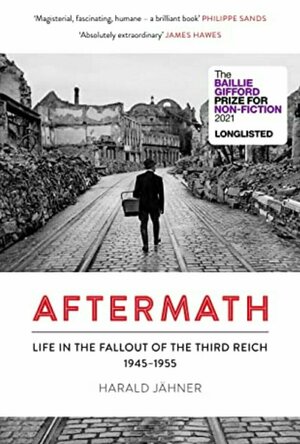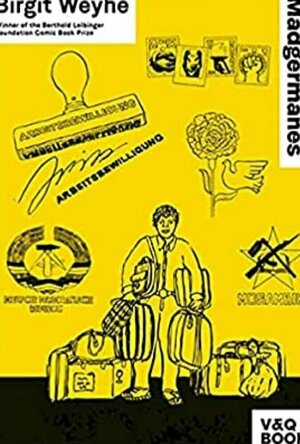Search
Search results
ClareR (5551 KP) rated Aftermath: Life in the Fallout of the Third Reich, 1945-1955 in Books
Feb 1, 2022
This is such an informative, interesting book about a period in German history that I know little about: 1945-1955. It shows that German cities were pretty much decimated by the end of the war, that ex-Nazi party members were forced to clean up the rubble and that most importantly, many Germans thought that they were hard done by, by the end of the war - their country in ruins, no industry and no food. But what’s most startling, is how quickly the German recovery was. Jähner states that this was in large part due to the return of the Germans who had been living in occupied countries.
The black market was also a huge earner for many German citizens: one teenager is described as having thousands of Marks worth of cigarettes in his house. Money was there to be made for the improvising, bold, German!
What probably resonated with me most, was the lot of the German woman. They had been expected to be the perfect German Female during National Socialism, then experienced a kind of social and sexual liberation after the end of the war. However, when their husbands and men returned from captivity (or just made their ways home), they found themselves being expected to revert to the stereotypical role of the housewife. But they wanted more. They wanted to continue in careers, they wanted equality, and they didn’t necessarily want to deal with broken, defeated husbands (as cruel as this may seem).
What really surprised me, was how was how former Nazi party members still worked in positions of influence, both politically and in industry - and this was the case in both East and West Germany. Even though the Allies made a point of ‘educating’ German citizens about the holocaust, National Socialists seemed to largely escape punishment and carried on with their lives. Their children may have had their doubts as to their parents innocence, and the real movement to ‘out’ the national guilt didn’t really get going until the 1960’s, but there was dissent in the 1950’s already.
I could go on. This is such an interesting book, and written so accessibly. It didn’t read at all like a dry history book, and the photos and posters from the time are well chosen and really add to the book as a whole. This isn’t just a history book for history buffs.
The black market was also a huge earner for many German citizens: one teenager is described as having thousands of Marks worth of cigarettes in his house. Money was there to be made for the improvising, bold, German!
What probably resonated with me most, was the lot of the German woman. They had been expected to be the perfect German Female during National Socialism, then experienced a kind of social and sexual liberation after the end of the war. However, when their husbands and men returned from captivity (or just made their ways home), they found themselves being expected to revert to the stereotypical role of the housewife. But they wanted more. They wanted to continue in careers, they wanted equality, and they didn’t necessarily want to deal with broken, defeated husbands (as cruel as this may seem).
What really surprised me, was how was how former Nazi party members still worked in positions of influence, both politically and in industry - and this was the case in both East and West Germany. Even though the Allies made a point of ‘educating’ German citizens about the holocaust, National Socialists seemed to largely escape punishment and carried on with their lives. Their children may have had their doubts as to their parents innocence, and the real movement to ‘out’ the national guilt didn’t really get going until the 1960’s, but there was dissent in the 1950’s already.
I could go on. This is such an interesting book, and written so accessibly. It didn’t read at all like a dry history book, and the photos and posters from the time are well chosen and really add to the book as a whole. This isn’t just a history book for history buffs.
ClareR (5551 KP) rated Madgermanes in Books
Feb 20, 2022
This is a really interesting period of history (for me, anyway!) and I enjoyed finding out about the ‘Madgermanes” or the Mozambicans who went to work in East Germany. After the wall between East and West Germany was erected, East Germany realised that they’d lost a lot of their workers to the West. So East Germany chose Mozambique as a sister country, and workers were sent to the GDR with promises of education, good work and good wages. Whilst they did get some education (if they largely sorted it out for themselves), the work could be simple and repetitive. What’s more, they only received half of their wages. They never got the half that had been sent back to Mozambique for ‘safekeeping’.
Housing for these visiting workers was usually in basic hostels, shared rooms, and away from the East Germans. Mixing was discouraged, as were relationships. Pregnancies were either terminated or the woman was sent home.
The pictures in the book are a wonderful mix of African and European, and some really big feelings are clearly illustrated. I loved it. I’d be really interested to know how many Mozambicans were able to stay in Germany and become German citizens. The novel implies that life was difficult for those who returned to Mozambique, financially, socially and culturally.
It’s a fascinating read, and one I’d recommend.
Housing for these visiting workers was usually in basic hostels, shared rooms, and away from the East Germans. Mixing was discouraged, as were relationships. Pregnancies were either terminated or the woman was sent home.
The pictures in the book are a wonderful mix of African and European, and some really big feelings are clearly illustrated. I loved it. I’d be really interested to know how many Mozambicans were able to stay in Germany and become German citizens. The novel implies that life was difficult for those who returned to Mozambique, financially, socially and culturally.
It’s a fascinating read, and one I’d recommend.
ClareR (5551 KP) rated The German House in Books
Dec 30, 2019
The German House is set in Frankfurt in 1963 at the time of the Auschwitz trials. Eva Bruhns is a 24 year old translator, and is asked to translate the testimony of the Polish speaking Jews who were imprisoned at Auschwitz. Eva was a small child during the war, and remembers little of it. She seems to be mostly concerned with her romance and possible engagement to Jürgen Schoorman, a wealthy businessman. However, when David Miller, a Canadian lawyer who is working for the prosecution at the trials, hires Eva as a translator, her world view and her opinion of her parents and the Germans involved in the war, changes. Her parents don’t want to talk about their involvement in the war, and Jürgen doesn’t think that she should be involved in something so distasteful. But this isn’t just a coming of age story. Granted, Eva does grow in this novel. She learns about the collective guilt of the German nation with regards to the Holocaust, and looks at how the children of the war generation reacted to something that was in effect hidden from them. They called it Vergangenheitsbewältigung - the struggle to come to term with and overcome the past. Young Germans wanted to analyse, digest and learn to live with the past, and the Holocaust in particular. Eva can’t understand why her parents will not own up to their share of the guilt.
I really enjoyed this novel. It was hard-going at times, and it did read like a translated novel. It did however, catch the spirit of the time. Eva’s longing to break out of the societal restrictions of the time (for example when she refers to how much she likes a new Beatles song that Jürgen can’t understand, he doesn’t like pop music) and Jürgen’s wish that she stops work as soon as she gets engaged (as a modern woman, I was positively fuming at this point!!).
I was fascinated by the trip the Court makes to Auschwitz - somewhere I’ve never been, and after a trip to Oranienburg (a camp for political prisoners outside Berlin), I feel that I would struggle to go. This was one of the most emotional parts of the book.
The side story involving Eva’s older sister is also fascinating, and I feel portrays the effect of seeing so much violence and hatred as a young child (no spoilers here!).
All in all, after I got used to the writing style, I really enjoyed this. It was an interesting insight into the post-war years, and West Germany’s reaction to the damage and destruction that the Nazis had caused during the Holocaust.
This is well worth a read.
Many thanks to NetGalley and the publisher for my copy of this book to read and honestly review.
I really enjoyed this novel. It was hard-going at times, and it did read like a translated novel. It did however, catch the spirit of the time. Eva’s longing to break out of the societal restrictions of the time (for example when she refers to how much she likes a new Beatles song that Jürgen can’t understand, he doesn’t like pop music) and Jürgen’s wish that she stops work as soon as she gets engaged (as a modern woman, I was positively fuming at this point!!).
I was fascinated by the trip the Court makes to Auschwitz - somewhere I’ve never been, and after a trip to Oranienburg (a camp for political prisoners outside Berlin), I feel that I would struggle to go. This was one of the most emotional parts of the book.
The side story involving Eva’s older sister is also fascinating, and I feel portrays the effect of seeing so much violence and hatred as a young child (no spoilers here!).
All in all, after I got used to the writing style, I really enjoyed this. It was an interesting insight into the post-war years, and West Germany’s reaction to the damage and destruction that the Nazis had caused during the Holocaust.
This is well worth a read.
Many thanks to NetGalley and the publisher for my copy of this book to read and honestly review.



